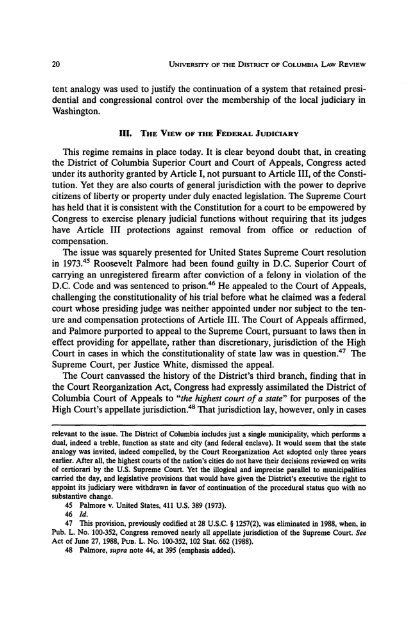Download Electronic Version - UDC Law Review
Download Electronic Version - UDC Law Review
Download Electronic Version - UDC Law Review
Create successful ePaper yourself
Turn your PDF publications into a flip-book with our unique Google optimized e-Paper software.
20 UNIVERSITY OF THE DISTRICf OF COLUMBIA LAW REVIEW<br />
tent analogy was used to justify the continuation of a system that retained presidential<br />
and congressional control over the membership of the local judiciary in<br />
Washington.<br />
III. THE VIEW OF THE FEDERAL JUDICIARY<br />
This regime remains in place today. It is clear beyond doubt that, in creating<br />
the District of Columbia Superior Court and Court of Appeals, Congress acted<br />
under its authority granted by Article I, not pursuant to Article III, of the Constitution.<br />
Yet they are also courts of general jurisdiction with the power to deprive<br />
citizens of liberty or property under duly enacted legislation. The Supreme Court<br />
has held that it is consistent with the Constitution for a court to be empowered by<br />
Congress to exercise plenary judicial functions without requiring that its judges<br />
have Article III protections against removal from office or reduction of<br />
compensation.<br />
The issue was squarely presented for United States Supreme Court resolution<br />
in 1973. 45 Roosevelt Palmore had been found guilty in D.C. Superior Court of<br />
carrying an unregistered firearm after conviction of a felony in violation of the<br />
D.C. Code and was sentenced to prison. 46 He appealed to the Court of Appeals,<br />
challenging the constitutionality of his trial before what he claimed was a federal<br />
court whose presiding judge was neither appointed under nor subject to the tenure<br />
and compensation protections of Article III. The Court of Appeals affirmed,<br />
and Palmore purported to appeal to the Supreme Court, pursuant to laws then in<br />
effect providing for appellate, rather than discretionary, jurisdiction of the High<br />
Court in cases in which the constitutionality of state law was in question. 47 The<br />
Supreme Court, per Justice White, dismissed the appeal.<br />
The Court canvassed the history of the District's third branch, finding that in<br />
the Court Reorganization Act, Congress had expressly assimilated the District of<br />
Columbia Court of Appeals to "the highest court of a state" for purposes of the<br />
High Court's appellate jurisdiction. 48 That jurisdiction lay, however, only in cases<br />
relevant to the issue. The District of Columbia includes just a single municipality, which performs a<br />
dual, indeed a treble, function as state and city (and federal enclave). It would seem that the state<br />
analogy was invited, indeed compelled, by the Court Reorganization Act adopted only three years<br />
earlier. After all, the highest courts of the nation's cities do not have their decisions reviewed on writs<br />
of certiorari by the U.S. Supreme Court. Yet the illogical and imprecise parallel to municipalities<br />
carried the day, and legislative provisions that would have given the District's executive the right to<br />
appoint its judiciary were withdrawn in favor of continuation of the procedural status quo with no<br />
substantive change.<br />
45 Palmore v. United States, 411 U.S. 389 (1973).<br />
46 Id.<br />
47 This provision, previously codified at 28 U.S.C. § 1257(2}, was eliminated in 1988, when, in<br />
Pub. L. No. 100-352, Congress removed nearly all appellate jurisdiction of the Supreme Court. See<br />
Act of June 27, 1988, PUB. L. No. 100-352, 102 Stat. 662 (1988).<br />
48 Palmore, supra note 44, at 395 (emphasis added).














